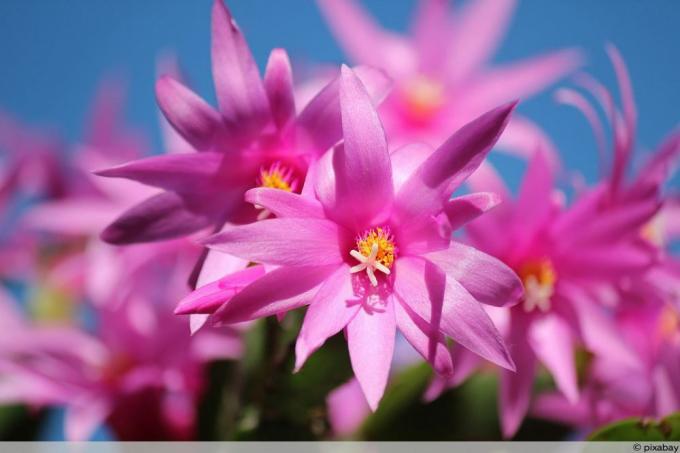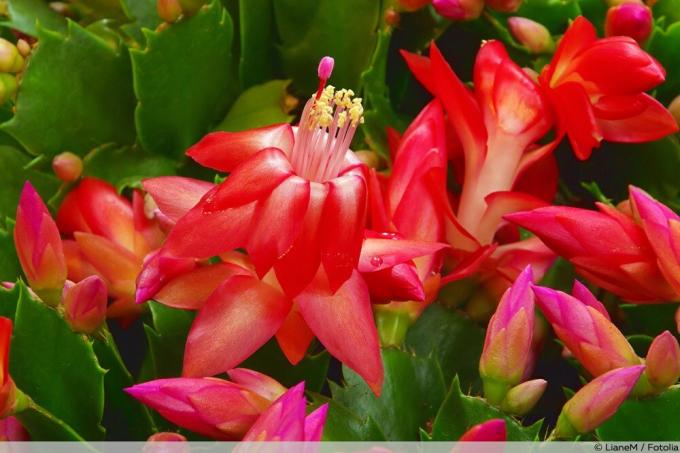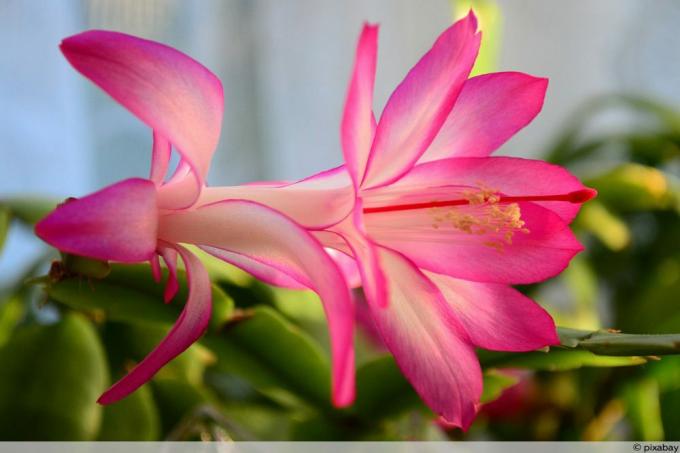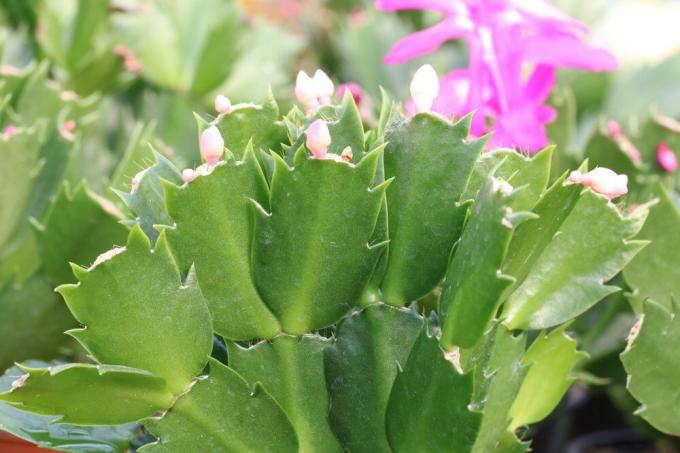
table of contents
- Characteristics
- Location
- Substrate
- to water
- Fertilize
- sowing
- Cuttings
- Repot and plant
- Overwinter
- Pests and diseases
Profile and care information open +conclude -
- Flower color
- yellow, orange, pink, red, white
- Location
- Partial shade, sunny
- Heyday
- January, November, December
- Growth habit
- flat-growing, overhanging
- height
- up to 45 cm high
- Soil type
- sandy, loamy
- Soil moisture
- moderately moist, fresh
- PH value
- neutral
- Limescale tolerance
- Calcium intolerant
- humus
- rich in humus
- Poisonous
- Yes
- Plant families
- Cactus family, Cactaceae
- Plant species
- Potted plants, container plants, house plants
- Garden style
- Conservatory, pot garden
Of the Christmas cactus comes from the rainforest and has its extraordinary name (Schlumbergera) from its inventor Frédéric Schlumberger. The large flowers that are present at Christmas time stand out. The robust cactus species needs little care, but a few conditions must still be met in the local area. A little horticultural skill is required, especially when overwintering and propagating, but the cactus species is also suitable for beginners.
Characteristics
- belongs to the cactus family (Cactaceae)
- comes from Brazil
- needs a bright location without exposure to sunlight
- does not tolerate calcareous water
- blooms between November and December (sometimes also in January)
- Flower color: red, pink, white, yellow, orange
- Soil: neutral pH value, sandy to loamy, moderately moist to fresh
- is used as winter decoration in hanging baskets
- is poisonous to humans and animals
- Growth height up to 45 cm
Location
It is often said that a cactus plant is only comfortable in full sun. A place that is too sunny is unsuitable at Schlumbergera. Although it comes from the subtropics, it does not tolerate direct sunlight. Above all, the midday sun must be avoided.
A bright, but not directly sunny place is ideal. In the morning there can be a few hours of sunshine, and the mild afternoon sun is not a problem either. Light penumbra is also accepted by the Christmas cactus.
A place in the shade is by no means acceptable, because the plant cannot cope with a lack of light any more than with full sun. A lack of light means that the cactus species begins to grow rapidly and forms weak tissue.
Location tips:
- bright place with morning sun
- no blazing midday sun
- no place in full sun
- shady places are unsuitable
- Lack of light can have serious consequences
Substrate
Because of its home, the cactus needs both warmth and high humidity. A planter is suitable for the summer time, which can also be on the balcony. In the winter (from temperatures below 10 degrees) the cactus has to go back into the apartment.
There should be a sufficiently high level of humidity in the area; indoor fountains in the immediate vicinity are well suited. In winter, it is helpful to attach water dispensers to the heater to increase the humidity.
Substrate tips:
- Soil should be rich in humus
- only permeable soil is suitable
- normal potting soil can be used in combination with sand and clay
- Earth should be replaced every two years at the latest
to water

One of the most common myths surrounding cacti is that they can cope with drought. However, the fact is that cacti like the Christmas cactus also need a lot of water, but a deficiency only shows consequences late.
Lime-free water must be used for watering, the ideal watering time has come when the surface has dried off. Schlumbergera values it very much when it is wetted with a plant sprayer.
Important: Waterlogging can completely destroy the Christmas cactus!
With the help of a drainage system, it can be ensured that the irrigation water runs off and the roots do not run the risk of rot.
Overview of pouring tips:
- better than watering is sprinkling with water
- The substrate must dry off before the next watering
- Lay out expanded clay drainage in the pot
- Waterlogging must be avoided
- does not tolerate drought
Schlumbergera forms flowers that are visually reminiscent of orchids. However, without a resting period, the plant will not flower. During the resting phase, watering should only be done very seldom, when the soil is half dry. The temperatures in the winter quarters must not exceed 12 degrees. Only under these conditions does the plant develop its buds.
Fertilize
Schlumbergera is also happy about fertilizers, but the fertilizing time is from April to August at the most. For the rest of the year there is no need for any more nutrients. The right fertilizer is important so that the plant does not experience an excess of nutrients. Too many nutrients are just as harmful as too few.
Fertilizing tips:
- Cactus fertilizer from specialist shops is suitable
- Fertilizer should be added to the irrigation water
- Fertilize from April to August at the most
- the instructions of the manufacturer must be observed
- do not use organic fertilizers to protect the roots
sowing

Above all, a lot of patience is required to obtain Christmas cacti from seeds. Obtaining the seeds is work, because no Schlumbergera is able to fertilize itself. Germable seeds can only be obtained if there are several plants.
Important: In contrast to summer bloomers, the Christmas cactus lacks natural helpers that carry out pollination.
Cultivation from seeds is therefore only possible with human help. To carry out fertilization, run around the pistils with a small brush.
Important: Plants obtained from cuttings are not suitable for pollination of the mother plant.
When the fruit capsule has matured, the seeds can be harvested and must now rest in a cool, dry place for a few weeks. Cacti are light germs and need certain prerequisites for reproduction.
Promote germination:
- the best ambient temperature is between 24 and 28 degrees
- bright location without full sun is suitable
- lean cactus soil is used as soil
- a mixture of sand and earth is also suitable
- Spread the seeds widely on the earth
- is wetted with a water atomizer, do not pour
- Keep the soil moist, avoid standing water
- Germination can be accelerated in the mini greenhouse
Small greenhouses are ideal for helping Schlumbergera hybrids germinate. Even if there is no such thing, protection can be built with the help of a film. This is perforated so that air circulation is guaranteed. The film must not come into contact with the earth and must be ventilated daily.
It can take weeks or even months until the Schlumbergera hybrids actually show new shoot tips. During the entire time, care must be taken to ensure that the soil remains moist. Only from a height of 5 cm. it is advisable to put the new plants in individual pots.
Cuttings

Propagation with cuttings is far less complicated than obtaining seeds. To do this, it is enough to cut off some parts of the main plant and let them dry for 48 hours in a dark environment.
The growing location for the cuttings should look like this:
- Use cactus soil
- Cuttings must be inserted into the ground with the interface facing down
- Soil must be permanently slightly moistened
- a bright and warm stand is required
The developing cactus segments show how well it works with the formation of new roots. As soon as these have developed, the Christmas cactus can be pricked out and repositioned. The new location should also be bright and sunny; direct UV radiation should be treated with caution.
Tip: In the first few weeks, place the new cacti at a distance from the window sill and minimize this distance. In this way, you can prevent damage to the foliage right from the start.
Repot and plant
The Christmas cactus is very sensitive to the cold, so there is no need for frost. Even temperatures below 10 degrees ensure that Schlumbergera hybrids no longer feel good and damage occurs.
This is the main reason why the plant has no place in the garden bed, but belongs on the window sill at home. Even if the Christmas cactus can safely spend a few hours on the balcony in summer, it needs special protection.
Full sun is by no means acceptable, and heavy downpours can also damage the plant. Transplanting into the bed is not advisable, the cactus should remain in the bucket.
The optimal planter:
- Height approx. 4 cm more than the root
- Drainage from expanded clay or split advisable
- the substrate layer should be at least 5 cm. be
- repotting is required every two years
- Vigorous watering must be carried out after repotting
- Roots show when it is time for a new place
- Roots must never be cut off
Overwinter

The weather determines when the Christmas cactus should better move to the windowsill and no longer be allowed to remain outdoors. As soon as the thermometer shows less than 10 degrees, it is too cold for the exotic plant.
Before moving to winter quarters, you should check the roots and other parts of the plant for pests. Otherwise, beetles and spiders are sometimes brought into the interior. A cool environment is desirable between September and November, temperatures of a maximum of 15 degrees are well tolerated.
The winter quarters at a glance:
- no radiators in the immediate vicinity
- Dust the plant with water once a week
- Avoid drafts
- choose a shady spot in winter
- Simulate dry phase due to lack of water
- Do not fertilize during the resting phase
From December onwards, the temperature can be increased again, and the administration of water is then increased again. Now it's time for a lighter location too. The nutrient supply does not take place until spring. These measures can promote the flowering period.
During flowering:
- Water the Christmas cactus even while it is blooming
- no change of location during the flowering phase
Pests and diseases

Succulents are rarely attacked by pests. Usually the smallest pests, such as the leaf miner, are in the substrate, but not on the plant itself. the insects use the substrate to lay their eggs.
In a few cases, insects such as lice can also be attracted to the Christmas cactus. So that these do not spread in the first place, action must be taken:
- only use insecticides in exceptional cases
- all shoots should be cleaned with a damp cloth
- Stinging nettle brew is suitable for strengthening
- Leaves can be washed off with nettle stock
- regular checks are helpful
Attention root rot
Numerous defects that can occur in Schlumbergera are due to incorrect care. Overwatering is a major problem, as this can lead to fungus and root rot.
No fungicide can help against this type of fungal attack, once the root rot has set in, the cactus threatens to die!
Rescue measures in case of root rot:
- act immediately if there is little progress
- Place the plant completely in fresh substrate
- Do not water for at least a week
- Refrain from using fertilizer for several weeks
- cut cuttings in the event of severe head growth



